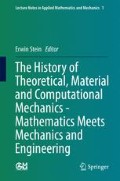Abstract
Human walking is an interdisciplinary research topic. It started in the Ancient World with early observations and questions in philosophy, it was treated in the Middle Ages with experiments and data collection by physiologists, and in the 20th century models were designed, equations of motion were generated and simulations by multibody dynamics approaches were performed. More recently parameter optimization was used to overcome the problem of muscle overactuation and inverse dynamics methods were introduced. In the first part of the paper the early developments and mechanism models are described while in the second part parameter optimization is applied as an example of recent research results on gait disorder simulations.
Access this chapter
Tax calculation will be finalised at checkout
Purchases are for personal use only
Preview
Unable to display preview. Download preview PDF.
References
Schiehlen, W.: PAMM Proc. Appl. Math. Mech. 11, 903–906 (2011)
Nussbaum, M.C.: Aristotle’s de motu animalium. Princeton University Press, Princeton (1978)
Borelli, G.A.: De motu animalium. Bernabo, Rome (1680)
Borelli, J.A.: De motu animalium. Boutesteyn, Leiden (1685)
Borelli, J.A.: De motu animalium. Petrum Gosse, The Hague (1743)
Borelli, G.A.: De motu animalium. Kessinger, Whitefish (2009)
Borelli, G.A.: Die Bewegung der Tiere. Akad Verlagsges, Leipzig (German transl. Mengeringhausen, M.) (1927)
Borelli, G.A.: On the Movement of Animals. Springer, Berlin (English transl. Maquet, P.) (1989)
Barthez, P.J.: Neue Mechanik der willkuerlichen Bewegungen des Menschen und der Thiere. Kuemmel, Halle (German transl. Sprengel, K.) (1800)
Weber, W., Weber, E.: Mechanik der menschlichen Gehwerkzeuge. Dieterich, Goettingen (1836)
Weber, W., Weber, E.: Mechanics of the Human Walking Apparatus. Springer, Berlin (English transl. Maquet, P., Furlong, R.) (1992)
Vierordt, H.: Ueber das Gehen des Menschen in gesunden und kranken Zustaenden. Laupp, Tuebingen (1881)
Fischer, O.: Theoretische Grundlagen fuer eine Mechanik der lebenden Koerper. Teubner, Leipzig (1906)
Wittenburg, J.: Dynamics of multibody systems. Springer, Berlin (2008)
Beletsky, V.V.: Two leg walking – The model problems of dynamics and control. Nauka, Moscow (1984)
Silva, M.P.T., Ambrosio, J.A.C.: Kinematic data consistency in the inverse dynamic analysis of biomechanical system. Multibody System Dynamics 8, 219–239 (2002)
Chenut, X., Fisette, P., Samin, J.C.: Recursive formalism with a minimal dynamic parametrization for the identification and simulation of multibody systems – application to the human body. Multibody System Dynamics 8, 117–140 (2002)
AnyBody Technology: Press. AnyBody Modeling SystemTM (2013), http://www.anybodytech.com (accessed January 25, 2013)
Zajac, F.E., Neptune, R.R., Kautz, S.A.: Biomechanics and muscle coordination of human walking, Part I. Gait Posture 16, 215–232 (2002)
Zajac, F.E., Neptune, R.R., Kautz, S.A.: Biomechanics and muscle coordination of human walking, Part II. Gait Posture 17, 1–17 (2003)
Anderson, F.C., Pandy, M.G.: A dynamic optimization solution for vertical jumping in three dimensions. Computer Meth. Biomechanics Biomedical Engineering 2, 201–231 (1999)
Anderson, F.C., Pandy, M.G.: Dynamic optimization of human walking. J. Biomechanical Eng. 123, 381–390 (2001)
Thelen, D.G., Anderson, F.C., Delp, S.L.: Generating dynamic simulations of movement using computed muscle control. J. Biomechanics 36, 321–328 (2003)
Thelen, D.G., Anderson, F.C.: Using computed muscle control to generate forward dynamic simulations of human walking from experimental data. J. Biomechanics 39, 1107–1115 (2006)
Seth, A., Pandy, M.G.: A neuromusculoskeletal tracking method for estimating individual muscle forces in human movement. J. Biomechanics 40, 356–366 (2007)
De Sapio, V., Khatib, O., Delp, S.: Least action principles and their application to constrained and task-level problems in robotics and biomechanics. Multibody System Dynamics 19, 303–322 (2008)
Rasmussen, J., Damsgaard, M., Voigt, M.: Muscle recruitment by the min/max crierion. J. Biomechanics 34, 409–415 (2001)
Garcia-Vallejo, D., Schiehlen, W.: 3D-Simulation of human walking by parameter optimization. Arch. Appl. Mech. 82, 533–556 (2012)
Kurz, T., Eberhard, P., Henninger, C., Schiehlen, W.: From Neweul to Neweul-M2: symbolical equations of motion for multibody system analysis and synthesis. Multibody System Dynamics 24, 25–41 (2010)
Umberger, B., Gerritsen, K., Martin, P.: A model of human muscle energy expendidure. Computer Meth. Biomechanics Biomedical Eng. 6, 99–111 (2003)
Ackermann, M.: Dynamics and energetics of walking with prostheses. Shaker, Aachen (2007)
Author information
Authors and Affiliations
Editor information
Editors and Affiliations
Rights and permissions
Copyright information
© 2014 Springer-Verlag Berlin Heidelberg
About this chapter
Cite this chapter
Schiehlen, W. (2014). On the Historical Development of Human Walking Dynamics. In: Stein, E. (eds) The History of Theoretical, Material and Computational Mechanics - Mathematics Meets Mechanics and Engineering. Lecture Notes in Applied Mathematics and Mechanics, vol 1. Springer, Berlin, Heidelberg. https://doi.org/10.1007/978-3-642-39905-3_7
Download citation
DOI: https://doi.org/10.1007/978-3-642-39905-3_7
Publisher Name: Springer, Berlin, Heidelberg
Print ISBN: 978-3-642-39904-6
Online ISBN: 978-3-642-39905-3
eBook Packages: EngineeringEngineering (R0)

